In this article, ACROBiosystems describes how new Omicron subvariants and recombinant strains could cause another peak in the epidemic, including BA.2.12.1, BA.4, BA.5 and the recombinant strains XD, XE and etc.
Global epidemic update
- As per the Worldometer, the complete number of verified COVID-19 cases surpassed 520 million on May 15th, 2022, with nearly 480,000 new cases throughout the world in a single day.
- The new statistics from Johns Hopkins University display that the increasing number of COVID-19 deaths in the United States has gone above one million as of May 17th, 2022, along with 8,260,909 confirmed cases.
- According to a WHO evaluation that was released on May 5th, 2022, nearly 14.9 million “excess deaths” were caused by COVID-19 from January 1st, 2020, to December 31st, 2021.
The pandemic’s risk is still prevalent, with the number of COVID-19 cases increasing again in America and Europe. The constant mutation of Omicron is causing a surge in cases in South Africa and other countries.
“The COVID-19 pandemic is only entering a new phase and is far from over,” stated the European Commissioner.
Recombinant strains still emerging
In March 2022, the news confirmed the break out of the latest COVID-19 recombinant strain, “Deltacron” (XD).
The World Health Organization (WHO) takes into account that the threat of COVID-19 evolution and the advent of new and mutated strains, such as recombinant strains remains high. With the breakthrough of XD, several recombinant strains like XE and XL have also appeared.
So far, 21 recombinant strains from XA to XW (skipping XI and XO) have been recorded in the Pangolin database. Scientists state that the recombination of variants is actually not rare, which might take place when the body has been infected with two or more COVID-19 variants simultaneously.
Even though the huge majority of recombinant variants diminish rapidly, there is still a chance for highly transmissible strains.
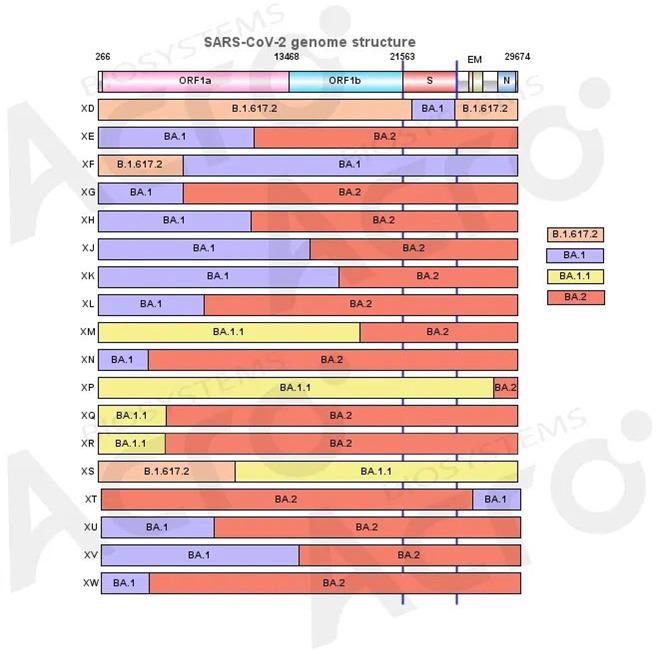
Overview of Omicron recombinant strain. Image Credit: ACROBiosystems
Excluding XD, the breakpoints in the majority of the recombinant strains were situated in the ORF region. This implies that the recombination does not impact the structural protein regions, like the nucleocapsid and spike protein.
The structural proteins of such strains are the same as those of the former strains. This identified that the recombination usually has no alteration in the recognition and antibody binding of the virus. But since the NSP protein in the ORF region functions at the time of viral infection, recombination in this region might impact the transferability of the virus.
Omicron keeps mutating
The Omicron variant has been on the constant rise and mutating at an alarming rate since its emergence in late 2021. The first-generation Omicron B.1.1.529 (BA.1) took on Delta’s dominant position in various countries globally in just a few weeks, until the following subvariant, BA.1.1, appeared.
In March 2022, there was a rapid spread of BA.2 subvariant in parts of Asia and Europe, and was thought to be highly infectious compared to BA.1 and could escape the immune response that was induced by present monoclonal antibodies.
As per the statistics, BA.2 has accounted for over 90% in the past six months. One more Omicron subtype, BA.3, was found in South Africa simultaneously but did not lead to many infections throughout the world.
In April 2022, various cases of a new Omicron subvariant, BA.2.12.1, displayed a volatile increase throughout the United States. The CDC evaluates that up to early May, cases of BA.2.12.1 were considered for 43% of all infections in the United States, which is much higher compared to the early February number which was around 0.2%.
Studies performed on the characteristics of the new variant indicate that BA.2.12.1 might be highly infectious, with a transmission rate of around 23% to 27% over the earlier dominant (BA.2). One more sublineage of BA.2, BA.2.13, has spread in Germany, Belgium, Denmark, and other European countries simultaneously, thereby infecting nearly 700 people.
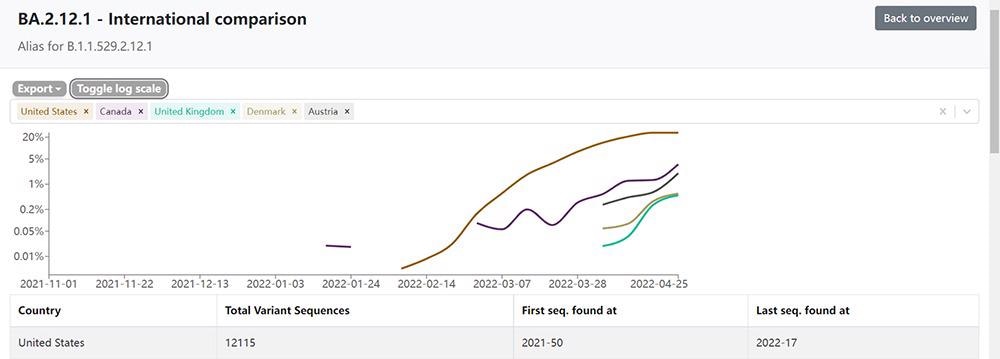
BA.2.12.1 transmission in the United States. Image Credit: ACROBiosystems
Since the start of the COVID-19 outbreak, there have been consecutive outbreaks of various new variants in the South African region. After Delta, Beta, and Omicron (B.1.1.529), South Africa is probably to see the fifth peak of the epidemic.
The World Health Organization (WHO) stated that the Omicron BA.4 and BA.5 variants broke out in South Africa in January 2022 and have spread to over 10 countries, thereby causing over 2000 cases.
Professor Xie Xiaoliang and his team reported a pre-print article on bioRxiv on May 2nd, 2022, reporting their studies on the new Omicron strains, BA.2.12.1, BA.2.13, BA.4, and BA.5. The outcomes displayed that all strains above contained L452 mutations and have greater potential transmissibility compared to BA.2.
In comparison with BA.1 and BA.3, the absence of G496S mutation in BA.2 subvariants enhanced its ability to bind to the ACE2 receptor. However, the initiation of F486V and the loss of Q493R might result in a reduction in hydrophilic and hydrophobic interactions, and hence considerably decrease the binding activity of BA.4 and BA.5.

Mutation sites of Omicron lineages. Image Credit: ACROBiosystems
Moreover, compared with BA.2, BA.2.12.1, BA.4, and BA.5 displayed stronger neutralization escape of plasma from boosted vaccines. Additional analysis of the escape mutation spectrum disclosed that the L452 mutation emerged under the immune stress that has been induced by Omicron patients.
ACROBiosystems is extremely vigilant about the growth of COVID-19. ACROBiosystems has developed a range of new mutants’ antigens simultaneously, such as BA.2.12.1, BA.2.13, BA.4, and BA.5.
Bearing L452 mutations in mind, products involving L452Q, L452M, L452R, and F486V, and other hot mutations were also made. ACROBiosystems is helping to expedite research on the efficiency of appropriate mutated strains and present vaccines, diagnostic reagents and therapeutic antibodies.
Main features
- Spans nearly all new Omicron subvariants: BA.1, BA.1.1, BA.2, BA.3, BA.2.12.1new, BA.2.13new, BA.4new, BA.5new;
- Uniquely developed products include hot mutations L452Q, L452M, L452R, F486V, etc.
- Purity is over 95% verified by SDS-PAGE and over 90% identified by MALS
- High bioactivity is confirmed by strict quality control, which is appropriate for ELISA/SPR/BLI and other experiments.
- Provide Spike trimer, S RBD, S1, S2, NTD, and N protein in biotinylated and unconjugated versions
Product list
Source: ACROBiosystems
| Lineage |
Molecule |
Cat. No. |
Product Description |
| BA.2.12.1 |
Spike RBD |
SPD-C522q |
SARS-CoV-2 Spike RBD, His Tag (BA.2.12.1/Omicron) |
| Spike protein |
SPN-C522d |
SARS-CoV-2 Spike Trimer, His Tag (BA.2.12.1/Omicron) |
| BA.2.9.1/BA.2.13 |
Spike RBD |
SPD-C522p |
SARS-CoV-2 Spike RBD, His Tag (BA.2.13/Omicron) |
| Spike protein |
SPN-C5227 |
SARS-CoV-2 Spike Trimer, His Tag (BA.2+L452M/Omicron) |
| BA.3 |
Spike RBD |
SPD-C522i |
SARS-CoV-2 Spike RBD, His Tag (BA.3/Omicron) |
| BA.4 |
Spike RBD |
SPD-C522r |
SARS-CoV-2 Spike RBD, His Tag (BA.4&BA.5/Omicron) |
| Spike protein |
SPN-C5229 |
SARS-CoV-2 Spike Trimer, His Tag (BA.4/Omicron) |
| Nucleocapsid protein |
NUN-C52Hw |
SARS-CoV-2 Nucleocapsid protein, His Tag (BA.4)/Omicron) |
| BA.5 |
Spike RBD |
SPD-C522r |
SARS-CoV-2 Spike RBD, His Tag (BA.4&BA.5/Omicron) |
| Spike protein |
SPN-C522e |
SARS-CoV-2 Spike Trimer, His Tag (BA.5/Omicron) |
| Nucleocapsid protein |
NUN-C52Hx |
SARS-CoV-2 Nucleocapsid protein, His Tag (BA.5)/Omicron) |
Assay data
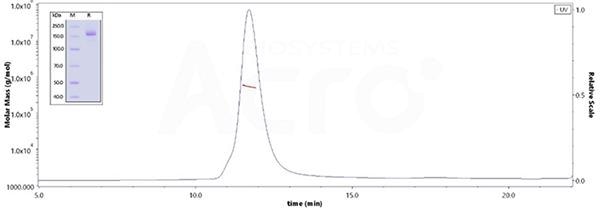
The purity of SARS-CoV-2 Spike Trimer, His Tag (BA.2.12.1/Omicron) (Cat.No. SPN-C522d) is more than 95% verified by SDS-PAGE and 90% verified by SEC-MALS. The molecular weight of this protein is around 510–560 kDa. Image Credit: ACROBiosystems
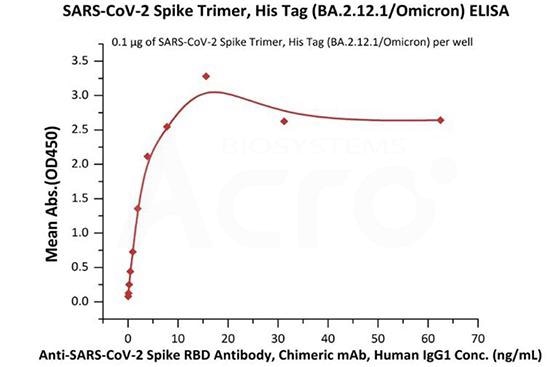
Immobilized SARS-CoV-2 Spike Trimer, His Tag (BA.2.12.1/Omicron) (Cat. No.SPN-C522d) at 1 μg/mL (100 μL/well) can bind Anti-SARS-CoV-2 Spike RBD Antibody, Chimeric mAb, Human IgG1 (Cat. No.S1N-M122) with a linear range of 0.1–4 ng/mL (Routinely tested). Image Credit: ACROBiosystems
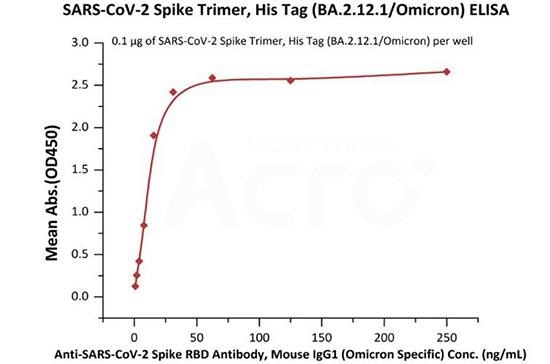
Immobilized SARS-CoV-2 Spike Trimer, His Tag (BA.2.12.1/Omicron) (Cat. No.SPN-C522d) at 1 μg/mL (100 μL/well) can bind Anti-SARS-CoV-2 Spike RBD Antibody, Mouse IgG1 (Omicron Specific) (Cat. No. SPD-M305) with a linear range of 1–31 ng/mL (Routinely tested). Image Credit: ACROBiosystems
References
- Chen, C. et al. CoV-Spectrum: analysis of globally shared SARS-CoV-2 data to identify and characterize new variants. Bioinformatics 38, 1735–1737, doi:10.1093/bioinformatics/btab856 (2021)
- Yunlong Cao, Ayijiang Yisimayi, Fanchong Jian, et al. BA.2.12.1, BA.4 and BA.5 escape antibodies elicited by Omicron infection. bioRxiv 2022.04.30.489997; https://doi.org/10.1101/2022.04.30.489997
About ACROBiosystems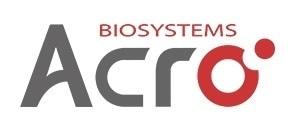
ACROBiosystems is a cornerstone enterprise of the pharmaceutical and biotechnology industries. Their mission is to help overcome challenges with innovative tools and solutions from discovery to the clinic. They supply life science tools designed to be used in discovery research and scalable to the clinical phase and beyond. By consistently adapting to new regulatory challenges and guidelines, ACROBiosystems delivers solutions, whether it comes through recombinant proteins, antibodies, assay kits, GMP-grade reagents, or custom services. ACROBiosystems empower scientists and engineers dedicated towards innovation to simplify and accelerate the development of new, better, and more affordable medicine.
Sponsored Content Policy: News-Medical.net publishes articles and related content that may be derived from sources where we have existing commercial relationships, provided such content adds value to the core editorial ethos of News-Medical.Net which is to educate and inform site visitors interested in medical research, science, medical devices and treatments.